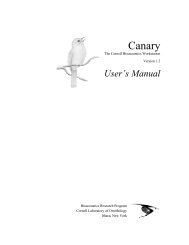Urban Bird Gardens Final Report - Cornell Lab of Ornithology ...
Urban Bird Gardens Final Report - Cornell Lab of Ornithology ...
Urban Bird Gardens Final Report - Cornell Lab of Ornithology ...
Create successful ePaper yourself
Turn your PDF publications into a flip-book with our unique Google optimized e-Paper software.
The Community Context<br />
Latinos in the U.S. comprise<br />
approximately 15% <strong>of</strong> the total<br />
population (U.S. Census, 2002). The<br />
Latino population in the United States<br />
is, <strong>of</strong> course, quite diverse. U.S.<br />
Latinos, for example, represent more<br />
than 20 different countries, include<br />
both U.S.-born and immigrant<br />
residents, and include communities<br />
with varied levels <strong>of</strong> acculturation,<br />
socio-economic status, and education.<br />
Furthermore, culture and cultural<br />
identity are not static, but rather<br />
dynamic, y , context-driven processes p<br />
(Chuang, 1994; Gutierrez and Rog<strong>of</strong>f,<br />
2003); they are mutually shaped by<br />
an individual’s perspectives and values<br />
and their environment (Hirschfeld,<br />
2002).<br />
Thus, when interpreting research<br />
results and determining the<br />
implications <strong>of</strong> study findings, it is<br />
critical to have a clear understanding<br />
<strong>of</strong> the specific segment <strong>of</strong> the Latino<br />
population who participated in a study<br />
and <strong>of</strong> the contextual issues at play<br />
within those communities. Results<br />
from this study, therefore, should not<br />
be generalized to Latinos as a whole.<br />
Study findings, however, are relevant<br />
for Latino communities with similar<br />
demographics and community<br />
contexts as those who participated in<br />
this study.<br />
Participating Communities<br />
Primarily two-parent<br />
households.<br />
Spanish-dominant .<br />
Immigration status varies.<br />
Working class and low income.<br />
(CBO partners reported that<br />
average average g household income<br />
less than $20,000 per family.)<br />
Low education levels,<br />
including varied literacy skills.<br />
Garibay Group │ <strong>Urban</strong> <strong>Bird</strong> <strong>Gardens</strong> Front-end Evaluation │ Summer 2009 6

















